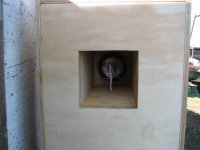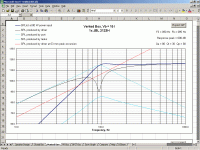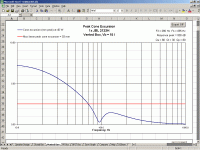IMHO if you only need 90Hz, I would consider going sealed.
Another option is to go open back like this. The rear reflections are quite nice when placed a little away from the wall. Only problem is you need a deep cabinet to prevent cancellation. Works in this instance though where the cut off is higher than 90Hz. If you're set on a tuned cabinet, the others will have to chime in as I'm not the expert.
Another option is to go open back like this. The rear reflections are quite nice when placed a little away from the wall. Only problem is you need a deep cabinet to prevent cancellation. Works in this instance though where the cut off is higher than 90Hz. If you're set on a tuned cabinet, the others will have to chime in as I'm not the expert.
Attachments
Depends... this is a midrange right? If you are considering active Xovers then there are more options here, but in general using passive design s/b keeping Xover frequencies away from box/baffle resonances. Please give more of your specific system and goals, otherwise we are guessing?
This is for a 10" midrange (JBL2123H). It has an 85 Fs. I need it to cover to 100 Hz. Closed it starts dropping off at 300 Hz. The only way I can get t 100 Hz is with a port tuned to 95- 105 Hz.
My electronic crossover will be at 90 Hz (18db), I can't change it.
So;
FS is at 85.
Crossover is at 90 Hz.
Box tnned to 95 -105 hz.
My understanding is that below port tunig your speaker is uncontroled. If I tune to 105 Hz, could I damage my speaker, will it sound uncontroled. I thought that their might be some generic ratio for this?
My electronic crossover will be at 90 Hz (18db), I can't change it.
So;
FS is at 85.
Crossover is at 90 Hz.
Box tnned to 95 -105 hz.
My understanding is that below port tunig your speaker is uncontroled. If I tune to 105 Hz, could I damage my speaker, will it sound uncontroled. I thought that their might be some generic ratio for this?
Hi
DL "Unibox" (MS excel SS) and model various BassReflex designs using your T/S. It will show excursion vs. freq. at various drive levels. If it shows a problem... the BR design has 2 resonant peaks make sure the active HP has atten. the drive level 10-20 dB before the lowest peak. The BR box response is close to a 4th order (24dB/oct) by itself so it can combine with the active HP filter giving a much steeper overall slope and can cause integration issues with the woofer's response. You can make it work but it's more work to do it.
The simple view is... you don't want the drivers frequency response to define/mess with the crossover frequencies. The most conservative approach is use a closed box design and modify the Xover frequencies. You might look at modding your Xover?
DL "Unibox" (MS excel SS) and model various BassReflex designs using your T/S. It will show excursion vs. freq. at various drive levels. If it shows a problem... the BR design has 2 resonant peaks make sure the active HP has atten. the drive level 10-20 dB before the lowest peak. The BR box response is close to a 4th order (24dB/oct) by itself so it can combine with the active HP filter giving a much steeper overall slope and can cause integration issues with the woofer's response. You can make it work but it's more work to do it.
The simple view is... you don't want the drivers frequency response to define/mess with the crossover frequencies. The most conservative approach is use a closed box design and modify the Xover frequencies. You might look at modding your Xover?
Also
You could really do something like Cal suggested (good idea)... Fb should approach 1.1xFs or so. Stuff the open chamber well to reduce any TL effects and slightly raise Qts. You want to increase Q to around 0.5-0.6 or equal to the active Xovers LP Q (can add a series resistor to increase more) Recheck excursion with Unibox for a closed box with Vb>Vas, and new Qts.
If this looks and measures ok, you could bypass the active Xover HP section and add an input series capacitor in front of the power amp for a 90Hz 1st order HP. So now the midrange open box response (2nd order) + added cap (1st order) = 18 dB/oct matching the active filter section as close as possible.
You could really do something like Cal suggested (good idea)... Fb should approach 1.1xFs or so. Stuff the open chamber well to reduce any TL effects and slightly raise Qts. You want to increase Q to around 0.5-0.6 or equal to the active Xovers LP Q (can add a series resistor to increase more) Recheck excursion with Unibox for a closed box with Vb>Vas, and new Qts.
If this looks and measures ok, you could bypass the active Xover HP section and add an input series capacitor in front of the power amp for a 90Hz 1st order HP. So now the midrange open box response (2nd order) + added cap (1st order) = 18 dB/oct matching the active filter section as close as possible.
mitchyz250f said:This is for a 10" midrange (JBL2123H). It has an 85 Fs. I need it to cover to 100 Hz. Closed it starts dropping off at 300 Hz. The only way I can get t 100 Hz is with a port tuned to 95- 105 Hz.
My electronic crossover will be at 90 Hz (18db), I can't change it.
So;
FS is at 85.
Crossover is at 90 Hz.
Box tnned to 95 -105 hz.
My understanding is that below port tunig your speaker is uncontroled. If I tune to 105 Hz, could I damage my speaker, will it sound uncontroled. I thought that their might be some generic ratio for this?
I wouldn't be concerned with mechanical damage with a tuning of 105 Hz. There are a couple things you might want to consider with a ported midbass though:
- You can vary the volume and tuning to counter the effect of baffle step. Most box programs show half space simulations but in a box that isn't the case... however if you use something like The Edge to get a rough idea what the rolloff will be from baffle step you can compensate for that by playing with the volume and tuning of the ported midbass.
- When tuning high the usual prediction formulas sometimes do not work because the limits of the usual model are being pushed. I have had a hard time pushing the tuning up past 100 Hz in anything over .5 ft^3, for example... the port area needs to be so big that the assumption that the compliance of the port and mass of the box are negligible aren't quite valid any more. My point is you'll might have to experiment more than you would with a more standard ported subwoofer.
mitchyz250f said:This is for a 10" midrange (JBL2123H). It has an 85 Fs. I need it to cover to 100 Hz. Closed it starts dropping off at 300 Hz.
A crude rule of thumb I use is another octave of useful extension before closed box F3 or rolloff. If your 10" is rolling off below 300Hz - you might be able to squeeze down to 150Hz out of it ported, otherwise you'll oversize the enclosure and get some funky midbass hump around your desired 90Hz and a sag in the 100-200 region.
Is the rolloff purely bafflestep related (or a natural driver anomaly?) Is grossly oversizing the baffle an option?
Cheers,
David.
It looks as though the speaker is 3 db down at 185 Hz in the suggested sealed .5 cu/ft box. In the same box tuned to 95 Hz I am down 3 db at 95 Hz. I would require a 3" dia. port that is 1.94" long (vent moch = 0.14) or a 4" dia. port that is 4.43" long (vent moch = 0.08). Will there be an audible difference in the different port dia.?
Everything seems reasonable, I think!? I am having a little problem getting 'unibox' to work correctly.
My group delay is 6ms at 100 Hz. Is this excessive?
Everything seems reasonable, I think!? I am having a little problem getting 'unibox' to work correctly.
My group delay is 6ms at 100 Hz. Is this excessive?
I have been tring to use Unibox and haven't ben able to make it work. Can anyone run the calculations for me so I can know the max wattage and db with a .55 box tuned to 95 Hz prior to reaching xmax?
Qts - .32
Vas - 19.8 Liters
Fs - 85 Hz
Re - 4.2 ohm
Le - .40
Xmax - 2.5 mm
Z - 8 ohm
Qms - 2.50
Qes - .37
SPL - 101 db
Pe - 250 watts
Bl - 13
Dia. - 201 mm
Sd - 316.1 cm2
Qts - .32
Vas - 19.8 Liters
Fs - 85 Hz
Re - 4.2 ohm
Le - .40
Xmax - 2.5 mm
Z - 8 ohm
Qms - 2.50
Qes - .37
SPL - 101 db
Pe - 250 watts
Bl - 13
Dia. - 201 mm
Sd - 316.1 cm2
Your TSPs aren't consistent. Either your BL is high or your Qes and Qts are high. All the other data is in agreement. Figure that out first as it will affect your box size and tuning frequency.
Since this driver has a low Qts and Xmax, you need to use it in a vented enclosure if you want to get high SPL out of it and xover at 100Hz. Your other option is to raise the xover to 200Hz and use it in a sealed enclosure.
Using it in a vented enclosure won't be awful since at least you have an active xover for it. If you do go vented, just put the xover frequency near the port tuning frequency. That will give you a decent 7th order (42dB/octave) rolloff. You will need to build a LP xover for the woofer that compliments it.
I don't remember the the xover frequency JBL used in the 3-way PA cabinet the 2123H was installed in, but I doubt it was under 200Hz. Probably 250-300Hz. The 2123H was always the driver that blew out first.
Since this driver has a low Qts and Xmax, you need to use it in a vented enclosure if you want to get high SPL out of it and xover at 100Hz. Your other option is to raise the xover to 200Hz and use it in a sealed enclosure.
Using it in a vented enclosure won't be awful since at least you have an active xover for it. If you do go vented, just put the xover frequency near the port tuning frequency. That will give you a decent 7th order (42dB/octave) rolloff. You will need to build a LP xover for the woofer that compliments it.
I don't remember the the xover frequency JBL used in the 3-way PA cabinet the 2123H was installed in, but I doubt it was under 200Hz. Probably 250-300Hz. The 2123H was always the driver that blew out first.
Wow, thanks. I threw this question out there and didn't really think I would get any help.
Specs - I got the specs from the 2123 spec sheet;
http://www.jblpro.com/pub/obsolete/2123.pdf
-The way I am interpreting these charts 80 watts takes the speaker to full excursion and a max SPL of 116 db. So how much power do I need to run the speakers cleanly?
-Xmax excursion occurs at 70 Hz without a crossover.
-According to the spec sheet ‘Max excursion before damage is 19mm’.What does this mean if the xmax is 2.4mm? I am a little confused.
-So with an 18db crossover at 90 Hz and tuned to 95 will I be protected from damage.
Again, I am so grateful for your help with this.
My problem with Unibox is that it will only allow me to change some of the fields.
Specs - I got the specs from the 2123 spec sheet;
http://www.jblpro.com/pub/obsolete/2123.pdf
-The way I am interpreting these charts 80 watts takes the speaker to full excursion and a max SPL of 116 db. So how much power do I need to run the speakers cleanly?
-Xmax excursion occurs at 70 Hz without a crossover.
-According to the spec sheet ‘Max excursion before damage is 19mm’.What does this mean if the xmax is 2.4mm? I am a little confused.
-So with an 18db crossover at 90 Hz and tuned to 95 will I be protected from damage.
Again, I am so grateful for your help with this.
My problem with Unibox is that it will only allow me to change some of the fields.
I wrote: '-Xmax excursion occurs at 70 Hz without a crossover'.
I think that is true for 40 watts, but at 80 watts I the speaker would be approaching failure at both 120 and 85 Hz. Is this correct?
Also, is there any difference in using a 2", 3" or 4" port if you have the space?
Thanks again for your help.
I think that is true for 40 watts, but at 80 watts I the speaker would be approaching failure at both 120 and 85 Hz. Is this correct?
Also, is there any difference in using a 2", 3" or 4" port if you have the space?
Thanks again for your help.
Hi
Remember total response is due to the driver + port output. That's why the total exceeds Xmax at the port tuning. Look at the ports contribution to the total on the first chart to verify.
When the driver starts to exceed Xmax = 2.4 mm the voice coil is leaving the influence of the magnetic gap. At this point IMD grows exponentially. When the driver hits Xmax damage, then the VC starts physically hitting things like the back plate.
I would be dubious of running this driver in a tuned port, unless you verify both the port and EQ filters with measurements. Notice how close the EQ has to be at the lower end of the ports output, so it will effect the total response shape.
You could still play with different alignments but the Fc will mostly have to be higher than what you want.
Remember total response is due to the driver + port output. That's why the total exceeds Xmax at the port tuning. Look at the ports contribution to the total on the first chart to verify.
When the driver starts to exceed Xmax = 2.4 mm the voice coil is leaving the influence of the magnetic gap. At this point IMD grows exponentially. When the driver hits Xmax damage, then the VC starts physically hitting things like the back plate.
I would be dubious of running this driver in a tuned port, unless you verify both the port and EQ filters with measurements. Notice how close the EQ has to be at the lower end of the ports output, so it will effect the total response shape.
You could still play with different alignments but the Fc will mostly have to be higher than what you want.
Thanks again. What does JBL mean in the spec sheet when they write ‘Max excursion before damage is 19mm (3/4 peak to peak)’. Does this mean that the speaker will have difficulty pushing itself to damage since the xmax is 2.5mm. Or am I lost here.
Also how much would it help if I lowered the Fb to 90 Hz. Nothing, almost nothing? Can I add passive networks to steepen the crossover?
Thanks again for your patients in educating me.
Also how much would it help if I lowered the Fb to 90 Hz. Nothing, almost nothing? Can I add passive networks to steepen the crossover?
Thanks again for your patients in educating me.
mitchyz250f said:Thanks again. What does JBL mean in the spec sheet when they write ‘Max excursion before damage is 19mm (3/4 peak to peak)’. Does this mean that the speaker will have difficulty pushing itself to damage since the xmax is 2.5mm. Or am I lost here.
I don't know what 3/4 PP means.
mitchyz250f said:
Also how much would it help if I lowered the Fb to 90 Hz. Nothing, almost nothing? Can I add passive networks to steepen the crossover?
Thanks again for your patients in educating me.
Play with Unibox if you don't know excel, then steeper learning ahead.
Yes you can EQ with passive, but not near Fb with series caps.
- Status
- This old topic is closed. If you want to reopen this topic, contact a moderator using the "Report Post" button.
- Home
- Loudspeakers
- Multi-Way
- porting a midbass


 Note with -3dB from max level
Note with -3dB from max level